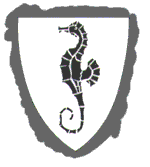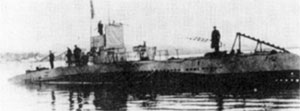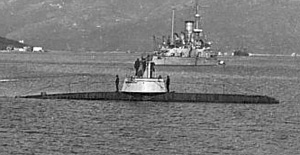
The Type UB I submarine was a class of small coastal submarines (U-boats) built in Germany at the beginning of the First World War. Twenty boats were constructed, most of which went into service with the German Imperial Navy Boats of this design were also operated by the Austro-Hungarian Navy and the Bulgarian Navy. In the Austro-Hungarian Navy, it was called the U-10 class.

The 1st U-boat flotilla also known as the Weddigen flotilla, was the first operational U-boat unit in Nazi Germany's Kriegsmarine (navy). Founded on 27 September 1935 under the command of Fregattenkapitän Karl Dönitz, it was named in honor of Kapitänleutnant Otto Weddigen. Weddigen, a U-boat commander during World War I, died on 18 March 1915 after his submarine U-29 was rammed by the British battleship HMS Dreadnought in the North Sea.
The 7th U-boat Flotilla, also referred to as the Wegener Flotilla, was a combat unit within the Kriegsmarine, the naval warfare branch of Nazi Germany. It was the seventh operational flotilla focused on U-boat activities.

The 5th U-boat Flotilla, also known as Emsmann Flotilla, was a U-boat flotilla of Nazi Germany's Kriegsmarine during World War II.

SM UB-46 was a Type UB II submarine or U-boat for the German Imperial Navy during World War I. UB-46 operated in the Mediterranean and the Black Seas, and was sunk by a mine in December 1916.

Lists of U-boats cover U-boats, military submarines operated by Germany, particularly in the First and Second World Wars.

SM UB-42 was a Type UB II submarine or U-boat for the German Imperial Navy during World War I. UB-42 operated in the Mediterranean and the Black Seas during the war. She was broken up at Malta in 1920.

SM UB-10 was a German Type UB I submarine or U-boat in the German Imperial Navy during World War I.

SM UB-16 was a German Type UB I submarine or U-boat in the German Imperial Navy during World War I. The submarine was sunk by a British submarine in May 1918.

SM UB-2 was a German Type UB I submarine or U-boat in the German Imperial Navy during World War I. She sank eleven ships during her career and was broken up in Germany in 1920.
The Pola flotilla was an Imperial German Navy (IGN) formation set up to implement the U-boat campaign against Allied shipping in the Mediterranean during the First World War in support of Germany's ally, the Austro-Hungarian Empire. It was formed in 1915 from the previously established U-Halbflottille Pola. It operated mainly from an advanced base at Cattaro in the Adriatic, rather than from Pola.
30th U-boat Flotilla of Nazi Germany's Kriegsmarine was formed in October 1942. Six U-boats reached the Black Sea after a transport over land and canals and operated from the harbours of Constanţa and Feodosiya from 1942 to 1944.
26th U-boat Flotilla was a training flotilla of Nazi Germany's Kriegsmarine during World War II.
German U-boat bases in occupied Norway operated between 1940 and 1945, when the Kriegsmarine, converted several naval bases in Norway into submarine bases. Norwegian coastal cities became available to the Kriegsmarine after the invasion of Denmark and Norway in April 1940. Following the conclusion of the Norwegian Campaign, the occupying Germans began to transfer U-boats stationed in Germany to many Norwegian port cities such as Bergen, Narvik, Trondheim, Hammerfest and Kirkenes. Initial planning for many U-boat bunkers began in late 1940. Starting in 1941, the Todt Organisation began the construction of bunkers in Bergen and Trondheim. These bunkers were completed by Weyss & Freytagg AG between 1942 and 1943.
German submarine U-771 was a Type VIIC U-boat of Nazi Germany's Kriegsmarine during World War II. She was ordered on 21 November 1940, and was laid down on 21 August 1942 at Kriegsmarinewerft, Wilhelmshaven, as yard number 154. She was launched on 26 September 1943 and commissioned under the command of Oberleutnant zur See Helmut Block on 18 November of that year.
German submarine U-794 was a Type XVIIA U-boat of Nazi Germany's Kriegsmarine during the Second World War. She was one of a small number of U-boats fitted with Hellmuth Walter's high test peroxide propulsion system, which offered a combination of air-independent propulsion and high submerged speeds. She spent the war as a trials vessel and was scuttled on 5 May 1945 in Gelting Bay.
Hartmann’s wolfpack was a formation of Nazi Germany's Kriegsmarine in World War II, a "wolfpack" of U-boats that operated during the early stages of the Battle of the Atlantic.
The Flanders U-boat flotillas were Imperial German Navy formations set up to prosecute the U-boat campaign against Allied shipping in the Western Approaches during the First World War. Originally operating as a flotilla, it was split in two during the latter part of the war.

A coastal submarine or littoral submarine is a small, maneuverable submarine with shallow draft well suited to navigation of coastal channels and harbors. Although size is not precisely defined, coastal submarines are larger than midget submarines, but smaller than sea-going submarines designed for longer patrols on the open ocean. Space limitations aboard coastal submarines restrict fuel availability for distant travel, food availability for extended patrol duration, and number of weapons carried. Within those limitations, however, coastal submarines may be able to reach areas inaccessible to larger submarines, and be more difficult to detect.
This page is based on this
Wikipedia article Text is available under the
CC BY-SA 4.0 license; additional terms may apply.
Images, videos and audio are available under their respective licenses.









